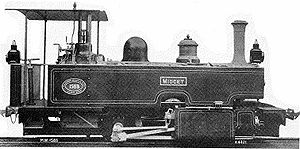CGR type C
| CGR type C SAR No.NG 20 |
|
|---|---|
|
CGR type C (factory recording)
|
|
| Numbering: | CGR: NG 41 |
| Number: | 1 |
| Manufacturer: | Manning Wardle |
| Year of construction (s): | 1902 |
| Type : | B n2t |
| Gauge : | 610 mm |
| Length over coupling: | 6,033 mm |
| Total wheelbase: | 1,372 mm |
| Service mass: | 15.2 t |
| Wheel set mass : | 7.6 t |
| Driving wheel diameter: | 660 mm |
| Cylinder diameter: | 229 mm |
| Piston stroke: | 356 mm |
| Boiler overpressure: | 96.5 N / cm² |
| Grate area: | 0.46 m² |
| Radiant heating surface: | 2.79 m² |
| Tubular heating surface: | 20.81 m² |
| Water supply: | 1.8 m³ |
| Fuel supply: | 0.23 tons of coal |
The Cape Government Railways (CGR) vehicle designated as Type C was a tank locomotive with a B wheel arrangement . It was procured in 1902 for the construction of the Avontuur Railway .
At first the locomotive was only called Midget , later it was assigned the number NG 41. The SAR gave it the new number NG 20 after 1910. After the line was completed, the locomotive was mainly used for shunting in Humewood Road station , but because of its economy compared to the larger types A and B, it also came before lighter trains from one or two Cars are used, especially on the weekends.
A class designation was no longer assigned to the locomotive because it was sold to the West Rand Consolidated Mines in 1921, long before class designations for narrow-gauge locomotives were introduced.
After it was decommissioned in 1959, it was put into storage and after the founding of the Museum of the Crown Gold Mine it was used under the name Taffy . It was operational until the mid-1980s and is now a static exhibit in the Gold Reef City theme park in Johannesburg .
technology
The locomotive has an outboard frame and cylinders, and the drive and coupling rods work on cranks. The flat slide valves arranged above the cylinders were moved by a Heusinger control . The side water tanks take up the entire length between the driver's cab and the front of the smoke chamber. The coal boxes are located on both sides of the standing boiler in the driver's cab.
The front part of the engine was originally provided with a protective cover, which was later removed - this was a common feature of the Yeo, Exe and Taw locomotives of the Lynton and Barnstaple Railway, also built by Manning Wardle .
literature
- Sydney M. Moir: Twenty-Four Inches Apart. The two-foot gauge railways of The Cape of Good Hope. 2nd edition (revised). Janus, Kempton Park 1981, ISBN 0-620-05460-3 .
- Leith Paxton, David Bourne: Locomotives of the South African Railways. A Concise Guide. C. Strui (Pty) Ltd., Cape Town 1985, ISBN 0-86977-211-2 .
